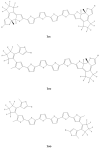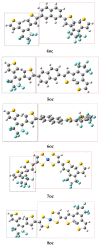Photoswitchable Molecular Units with Tunable Nonlinear Optical Activity: A Theoretical Investigation
- PMID: 37570617
- PMCID: PMC10419997
- DOI: 10.3390/molecules28155646
Photoswitchable Molecular Units with Tunable Nonlinear Optical Activity: A Theoretical Investigation
Abstract
The first-, second-, and third-order molecular nonlinear optical properties, including two-photon absorption of a series of derivatives, involving two dithienylethene (DTE) groups connected by several molecular linkers (bis(ethylene-1,2-dithiolato)Ni- (NiBDT), naphthalene, quasilinear oligothiophene chains), are investigated by employing density functional theory (DFT). These properties can be efficiently controlled by DTE switches, in connection with light of appropriate frequency. NiBDT, as a linker, is associated with a greater contrast, in comparison to naphthalene, between the first and second hyperpolarizabilities of the "open-open" and the "closed-closed" isomers. This is explained by invoking the low-lying excited states of NiBDT. It is shown that the second hyperpolarizability can be used as an index, which follows the structural changes induced by photochromism. Assuming a Förster type transfer mechanism, the intramolecular excited-state energy transfer (EET) mechanism is studied. Two important parameters related to this are computed: the electronic coupling (VDA) between the donor and acceptor fragments as well as the overlap between the absorption and emission spectra of the donor and acceptor groups. NiBDT as a linker is associated with a low electronic coupling, VDA, value. We found that VDA is affected by molecular geometry. Our results predict that the linker strongly influences the communication between the open-closed DTE groups. The sensitivity of the molecular nonlinear optical properties could assist with identification of molecular isomers.
Keywords: (hyper)polarizability; bis(ethylene-1,2-dithiolato); density functional theory; dithienylethene; excited-state energy transfer; molecular switches; photochromism; two-photon absorption.
Conflict of interest statement
The authors declare no conflict of interest.
Figures










Similar articles
-
Exploring Second-Order Nonlinear Optical Properties and Switching Ability of a Series of Dithienylethene-Containing, Cyclometalated Platinum Complexes: A Theoretical Investigation.J Phys Chem A. 2015 Jul 23;119(29):8174-81. doi: 10.1021/acs.jpca.5b03456. Epub 2015 Jul 1. J Phys Chem A. 2015. PMID: 26107466
-
Linear and nonlinear optical properties of cationic bipyridyl iridium(III) complexes: tunable and photoswitchable?Inorg Chem. 2011 Jun 6;50(11):5027-38. doi: 10.1021/ic2002892. Epub 2011 Apr 25. Inorg Chem. 2011. PMID: 21517053
-
Ruthenium-phenothiazine electron transfer dyad with a photoswitchable dithienylethene bridge: flash-quench studies with methylviologen.Inorg Chem. 2012 Apr 2;51(7):4335-42. doi: 10.1021/ic300048r. Epub 2012 Mar 22. Inorg Chem. 2012. PMID: 22435739
-
Switching of the triplet-triplet-annihilation upconversion with photoresponsive triplet energy acceptor: photocontrollable singlet/triplet energy transfer and electron transfer.J Phys Chem A. 2015 Jan 22;119(3):468-81. doi: 10.1021/jp5111828. Epub 2015 Jan 7. J Phys Chem A. 2015. PMID: 25514195
-
Photochromic DTE-Substituted-1,3-di(2-pyridyl)benzene Platinum(II) Complexes: Photomodulation of Luminescence and Second-Order Nonlinear Optical Properties.Inorg Chem. 2018 Jun 18;57(12):7051-7063. doi: 10.1021/acs.inorgchem.8b00733. Epub 2018 Jun 5. Inorg Chem. 2018. PMID: 29869490
Cited by
-
HOMA Index Establishes Similarity to a Reference Molecule.J Chem Inf Model. 2023 Dec 25;63(24):7744-7754. doi: 10.1021/acs.jcim.3c01551. Epub 2023 Dec 6. J Chem Inf Model. 2023. PMID: 38055931 Free PMC article.
-
Synthesis and Photochromic Properties of Diarylethene Derivatives with Aggregation-Induced Emission (AIE) Behavior.Materials (Basel). 2025 May 27;18(11):2520. doi: 10.3390/ma18112520. Materials (Basel). 2025. PMID: 40508517 Free PMC article.
References
-
- Galanti A., Santoro J., Mannancherry R., Duez Q., Diez-Cabanes V., Valasek M., De Winter J., Cornil J., Gerbaux P., Mayor M., et al. A New Class of Rigid Multi(azobenzene) Switches Featuring Electronic Decoupling: Unravelling the Isomerization in Individual Photochromes. J. Am. Chem. Soc. 2019;141:9273–9283. doi: 10.1021/jacs.9b02544. - DOI - PubMed
-
- Zhang L.Y., Friesner R.A., Murphy R.B. Ab initio quantum chemical calculation of electron transfer matrix elements for large molecules. J. Chem. Phys. 1997;107:450–459. doi: 10.1063/1.474406. - DOI
LinkOut - more resources
Full Text Sources
Miscellaneous

